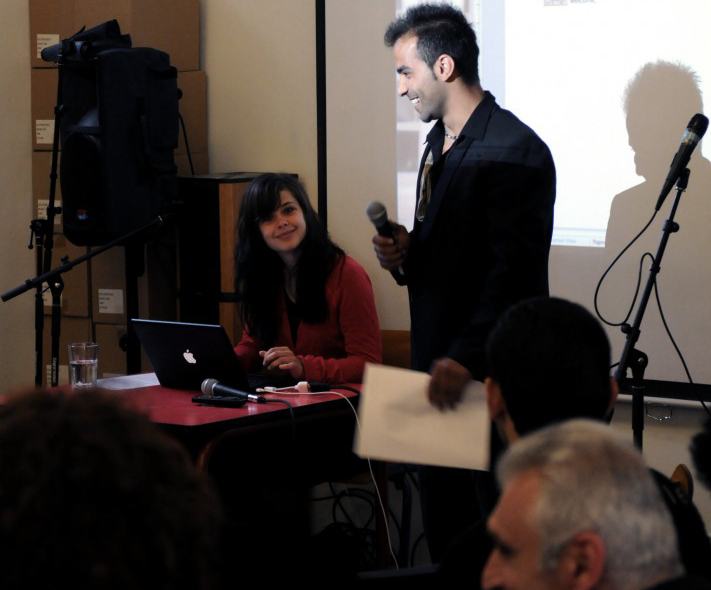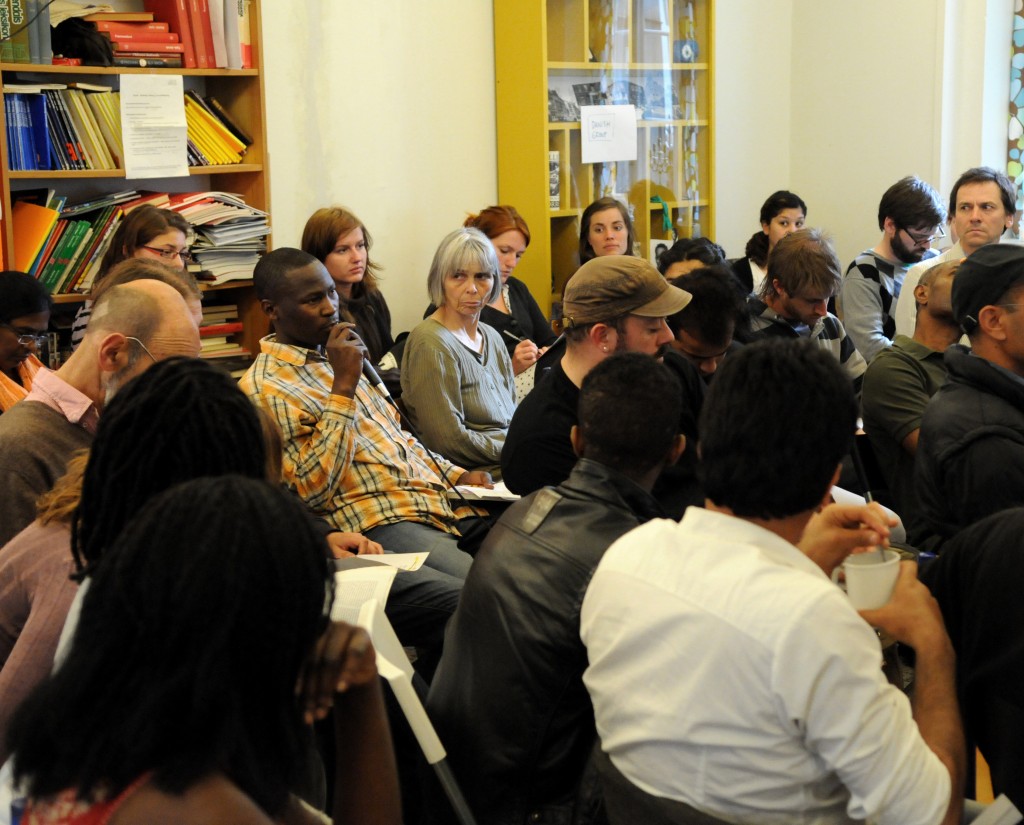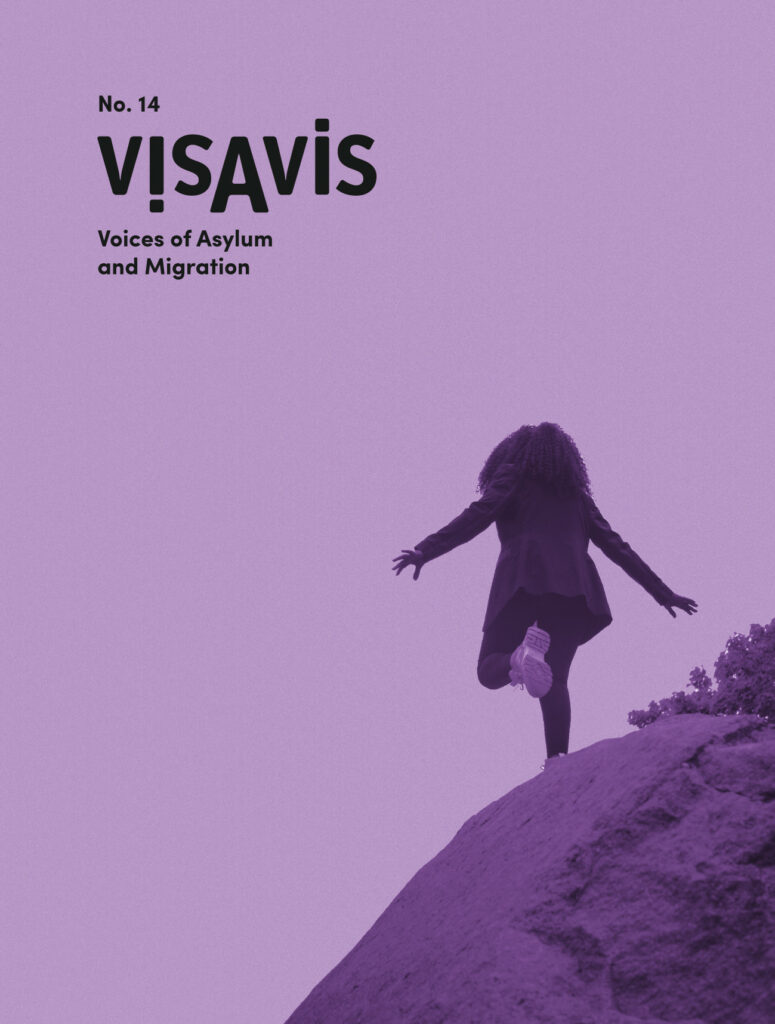Testimonies from The Trampoline House’s Public Hearing.
What is wrong with the Danish asylum system? And what can be done to improve it? On May 27, 2011 the user-driven culture house, the Trampoline House, organized a public hearing entitled “What is wrong with the Danish asylum system? What can be done to improve it?”
by the Trampoline House · Photos by Nikolaj Grønholdt
The purpose of the public hearing was to identify some of the major problems within the Danish asylum system and find solutions to these problems. Rather than inviting a series of Danish asylum experts, politicians and activists to answer these questions, the Trampoline House wanted to ask the people who are seeking asylum in Denmark what they think of the Danish asylum system and of life in the Danish asylum centers. Without access to any channels of expression, the voices of asylum seekers are often overlooked and ignored.
During the first part of the public hearing, asylum seekers were invited to critically identify what they considered to be the major problems within the Danish asylum system. During the second part of the hearing, we collectively tried to find solutions to these problems. Here we present testimonies from the hearing, and hope that this document will offer a base for future public hearings in the Trampoline House as well as for future dialogues with asylum experts, politicians, and activists on what must be done to improve in the Danish asylum system.
As Denmark’s new government begins its first days of work – one that has already announced a reform to the asylum system to allow asylum seekers to work and live outside of camps after a period of six month – the following testimonies are especially relevant. In order to make the Danish asylum system a good system, it is important to first understand what asylum seekers themselves think about the system and how it makes them feel excluded and disrespected.
What is wrong with the Danish asylum system?
Uncooperative EU structures
Many have voiced worries concerning the rise of Fortress Europe, and the dubious ability of the Dublin Convention and Regulation to adequately safeguard the rights of refugees. Indeed, the Regulation presents many obstacles for asylum seekers, many of which are merely technical but can significantly impair an asylum seeker’s ability to gain refugee status:
“According to the Dublin convention it is only possible to seek asylum in one country within the EU. That is a big problem for one of my friends. At the moment he lives in Sigerslev and he has been in Denmark for one year, but all his documents are in Greece. The police don’t do anything about it.”
The isolation and exclusion of asylum seekers from society
One of the major criticisms of the Danish asylum seekers regards its structure – the condition of the camps where they live, their segregation from society, and inability to work which often has very negative repercussions on asylum seekers’ state of mind. The policies are often interpreted as explicit indications on behalf of the Danish state to accept asylum seekers – and this not only has a negative impact on asylum seekers’ every day morale but also on their desire to integrate as future potential citizens:
“I don’t think that the Danish government wants asylum seekers in Denmark. If you look at all the rules that make it so difficult to seek asylum in Denmark, and how the people are living in the camps, the problems are clear to see. The fact that more than five people are living in the same room is inhumane and unfair. Even animals have better circumstances. Many asylum seekers have a good education and talents, but they cannot use it here because of all the strict rules. The Danish government pretends that the asylum seekers have a lot of rights, but the reality is different; they play with their hopes. I have never seen the politicians in the camps. If they went there, they would maybe see how things are and change it, but they don’t want that. It’s also a very big problem that the camps are so isolated from the big cities. It’s like a society where the sick and infected people are on one side and everybody else is on the other side.”
*
“I have been living in Sandholm since March 2010. There are many problems with asylum seekers who don’t have money, and therefore can’t afford the bus. As an asylum seeker in phase 1 you get 230 kr. per month plus food, in phase 2 you well get 2200 pr month, but no food, and in phase 3 you don’t get any money at all. If a person is in phase 3 and has no money, what do they do? In Allerød there’s no bus after 3 pm, and on Sundays there’s no bus at all. You can’t come back to the camp after 7 in the evening and that’s a big problem.”
*
“The system doesn’t allow asylum seekers to work. We are useful and educated, but all we can do is sit in the camps. Denmark could use our skills; if we could work, we would pay taxes and in the end of the day the money would come back to the State. In my opinion they should allow asylum seekers to work and not put them in camps. We are not criminals. If you leave your home, come to Denmark and are placed in a camp, it’s like being placed in a prison. Putting asylum seekers in closed camps isn’t a good thing.”
Inadequate medical attention
On a more day-to-day level, an issue which many asylum seekers have brought up is the inadequate medical attention in centres, and a certain apathy by the medical staff with regards to the health problems an asylum seeker may have:
“A major problem is medication. When you go to the nurse, the only thing you are given is pain killers (panodil, pinex etc.), without any diagnosis or real help. Once I had a friend who became very ill, but when she told the nurse, she was just told to go home and drink water. Her situation worsened before she was finally sent to the hospital.”
*
“There was a guy who committed suicide in Sandholm. The police beat him up and gave him a neck problem. He waited eight months to have medical care. Then he went to the roof of the immigration service where he was waiting in the cold without food for 48 hours. The problem is that the police didn’t do anything before he put himself in this very extreme position.”
The camps’ internal structure
The camps’ internal structure is a major issue for many asylum seekers. There are arguments both for and against gender-segregated camps as well as nationality-segregated camps, and authorities should reflect more deeply upon which way camps should be structured so as to minimize conflict and abuse without repressing its inhabitants:
“Sigerslev is a men’s camp, without any women. It’s like a boy’s/men’s school without ladies. A mixed camp would be much better. In terms of life style I don’t think this is fair. Red Cross and the immigration service should think about that.”
*
“I’m from Somalia. I came to Denmark in 1993 when I was 9 years old. We only lived in Denmark for some months and were then sent to another place. The biggest problem was the fact that people of different nationalities, backgrounds and with different traumas was placed together in one camp. It could have been a nice time, but it was a time full of conflicts because people couldn’t understand each other. There were a lot of problems with child abuse and maltreatment, which resulted in a lot of parents not letting their children go out. I don’t know what should have been done about it. It’s difficult to share your room with people from another country that you can’t understand.”
*
Overly long waiting periods
One of the most fundamental, if not the most fundamental, problem with the asylum system in Denmark is the long and undetermined waiting period that many asylum seekers must go through. Indeed, this waiting period often has detrimental effects on the psychological well-being of asylum seekers, whose days are reduced to simply waiting in limbo. Often, asylum seekers integrate themselves into Danish society during the years of waiting, and then are refused refugee status, making the re-integration in their homeland even more difficult:
“I have been waiting one year to be interviewed. When I got a negative answer, the police said that I was lying and that they needed more proof to give me refugee status. So I could only wait, wait and wait. After the interview, they told me to wait again because of the situation in Syria. I have been waiting for two years now. I can’t go back to Syria because of the situation there. Yesterday there was a guy in Sigerslev who committed suicide because of all the waiting. When you receive a negative asylum response, the police can come and get you and put you in a closed camp anytime.”
*
“There are no limits to the waiting. Not even murders stay in prison without knowing for how long they will remain there. There is a need to document your story; the legal aspect demands proofs of your story, but this is sometimes difficult for people who are suffering from traumas.”
Family reunification vs. asylum
An issue directly linked with overly long waiting times is the relationships that are fostered over the years between an asylum seekers and Danes around him or her. Indeed, sometimes asylum seekers integrate, get married, and have children in Denmark with a person of Danish nationality. However, their claims to family reunification – once their asylum application is rejected – are void and they find themselves forced apart from their families:
“People who have families are suffering under the rules, and are facing many problems. I have kids and I’m married here in Denmark. I was told to leave the country, without any thought to my family. There’s a guy who was sent home, he has family here and can’t come back to Denmark. You can only apply for asylum one time. The authorities don’t want to help him. I was asked to go back to Uganda and then apply for family unification and not asylum. And it’s extremely difficult to receive family unification, not to say almost impossible.”
*
“There is a rule in the EU saying that if you have a child, you have the right to stay. I live with a guy, who has two kids here, but they can’t see their dad, and that’s not good. The kids cannot keep their dad because of the rules.”
The criminalization of asylum seekers
Finally, a last major issue for asylum seekers with the system in Denmark is the fact that they are often confused or linked to criminals. This serves only to reinforce the disrespect and lack of rights given to asylum seekers and completely overlooks the fact that they come to Denmark not to exploit the system but because of war and other life-threatening situations in their home country:
“I have a question concerning the criminalization of asylum seekers: Why are asylum seekers placed in the jail? I left my own country because of war etc. Denmark should give asylum seekers rights; they come here because they have problems. We are in a European country, which means that Denmark should respect the Dublin Convention.”
How can the asylum system be improved?
Giving asylum seekers the right to equal rights
A fundamental way to improve the asylum system in Denmark is to give asylum seekers more rights, the right to study, as well as to work and contribute to Danish society.
“My wish is that the government would give asylum seekers work permits and a possibility to have their own place to live. I have been living in Sandholm for one year and a half. One year ago my asylum application was denied, because they didn’t think that I look like a Somalian, and now I can’t continue my school. I wish I could continue my studies even though I got a negative response.”
*
“If the Danish government would allow people to work, it would help the economy of this country. We are people from many fields, and we are willing to work. It’s not logical to keep somebody who is educated in a camp and give him pocket money. It’s not logical. Also, I see a lot of xenophobia. If only people would understand our situation. The Danish government can’t escape from respecting human rights.”
*
“What I think is wrong is that people who are living in the camps don’t have the same rights as the rest of the citizens. In a democracy people should have the same rights and living conditions, the same choices and possibilities. The government should stop pretending that they are making progress and be honest instead.”
Greater openness and political will from Danes
Inevitably, while politicians can take the lead in promoting certain changes, their policy decisions are often based on their electorate. The recent electoral success of the left-wing in Denmark has raised hopes about a change in the Danish asylum system, but this must also be accompanied by greater openness from Danes:
“All Danes should know at least one or two asylum seekers. It’s the first time for me to meet asylum seekers here in the T-house. And for me as a Dane it’s a gift to meet all these fantastic people. If all Danes could have this experience, they would understand the situation, vote differently and affect politicians.”
*
“The Danish system is a fair system. All of you Danes who are here are able to vote out this government. And you should do that! I’m a Somalian and have been here for eight months and I don’t know anything about my future. We can only solve this through Danish votes. Please Danes, vote out this government!”
Shorter and defined waiting times
Finally, what is crucial for asylum seekers is that the waiting time when applying for refugee status be not only shorter, but also pre-defined. This would decrease not only the negative impact of waiting and uncertainty on an asylum seekers’ well-being but also allow them not to invest and integrate into Danish society for several years to then be ripped away from it at the most unexpected moment:
“We are demanding a time limit for the application process.”
*
“One day when I had to wait for the bus, because it was five minutes late, all the Danes were very upset, which shows that time is important for everybody. And for us it’s not a question of five minutes.”
Decriminalize asylum issues
At a fundamental level, asylum seeking should not be equated with criminality and illegal immigrants, and consequently, the role of the police in managing asylum seekers should be completely reconsidered:
“Because asylum seekers are not criminals, the police should have nothing to do with the asylum system.”
An asylum system without camps? Still a contentious issue
The new government has announced that it will change the asylum system in Denmark and allow asylum seekers to live and work outside the camps. These changes are extremely positive and, if instated, are certain to radically change – for the better – the lives of asylum seekers. However, it is important that this will not remove the possibility for those asylum seekers that need it to have the camps as a point of reference:
“It’s not a good idea to close the camp and send asylum seekers to the street. It’s not easy to walk around in the street without having food and a place to sleep. The government should think about how to bring incomes to the people living in the camps.”
*
“The Committee for Refugees Underground thinks that we should close the camp and open smaller houses where people could live together like a family and then open support centres.
*
“There should be a temporarily hostel for people who arrive. Most of the people who come to Denmark come here because the have problems in their home country, they don’t just come here to stand in line waiting for food. They don’t need food, clothes and so forth, they just need to be safe.”
*


